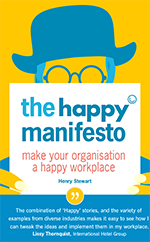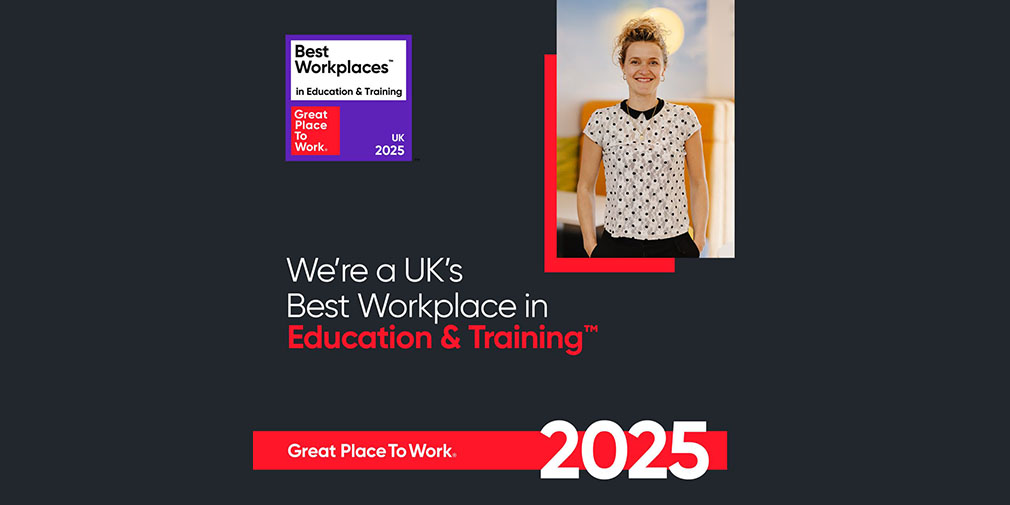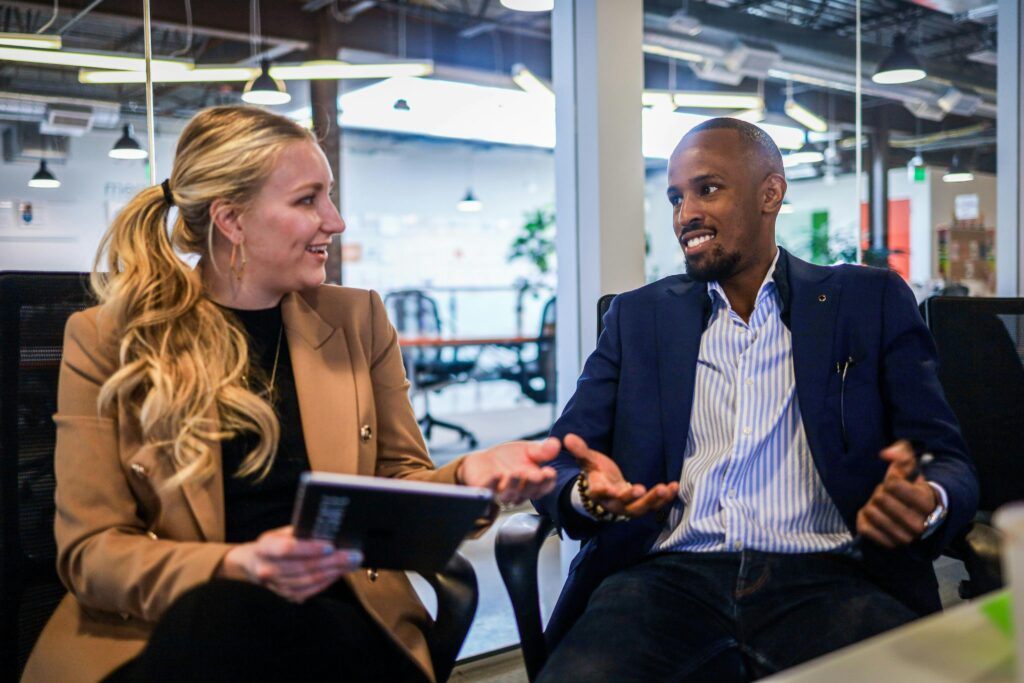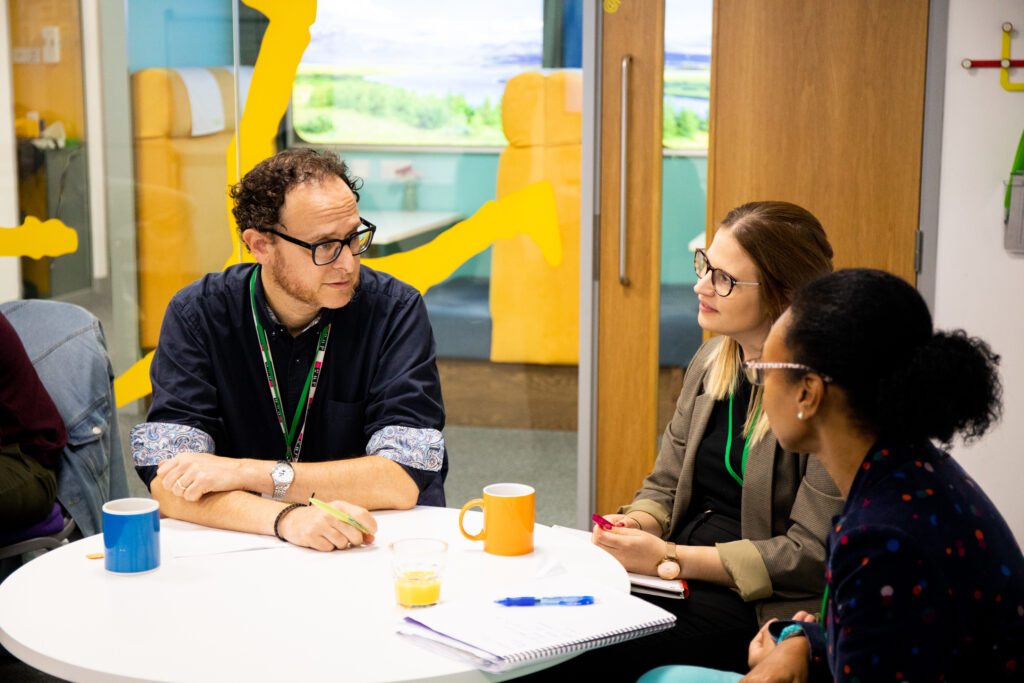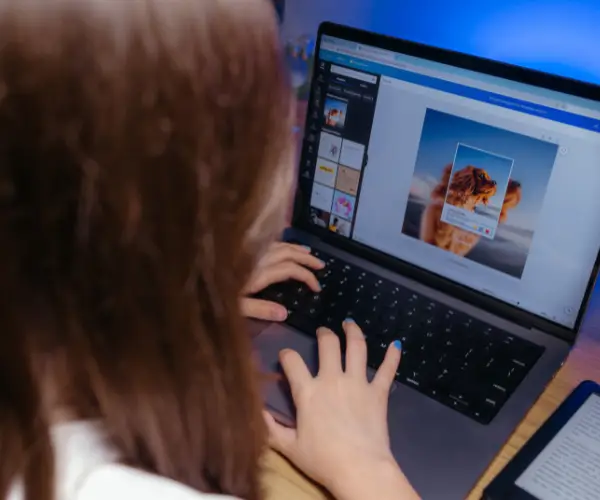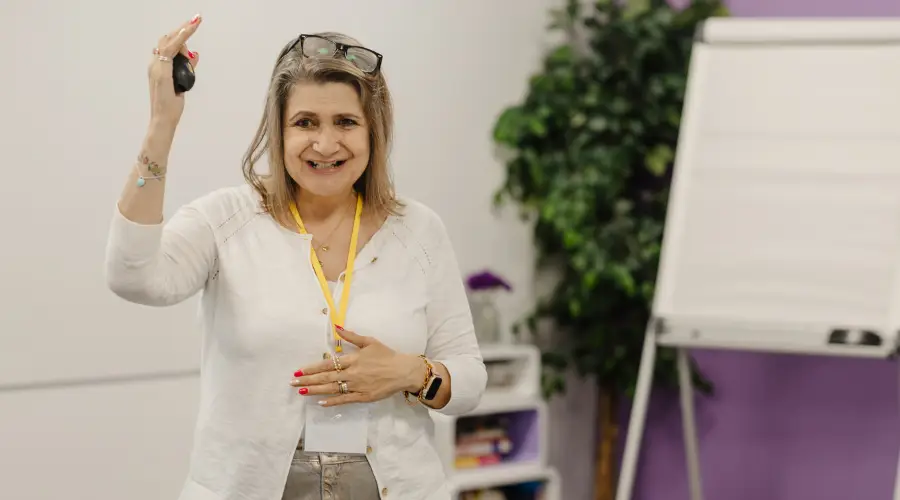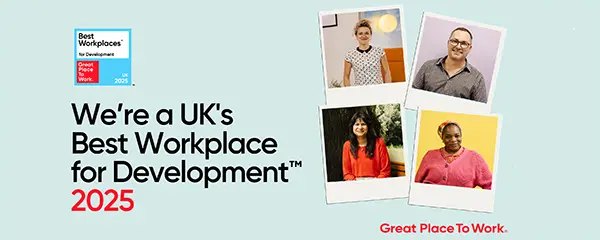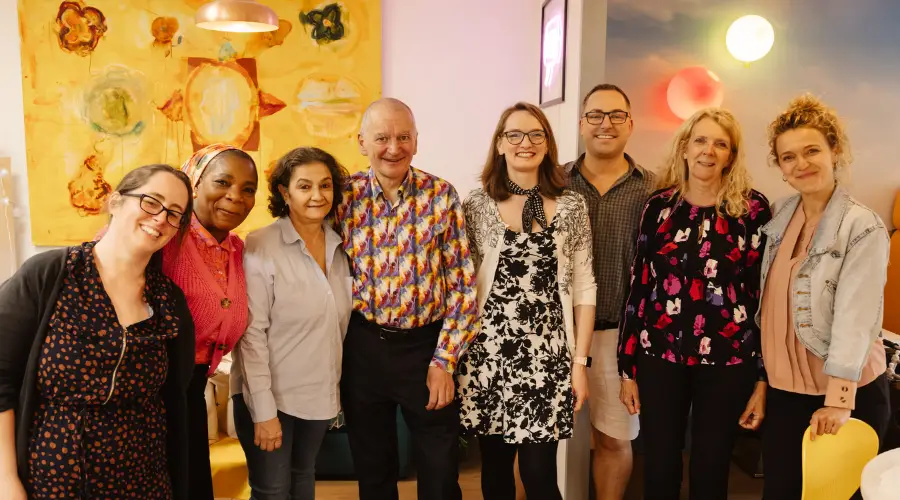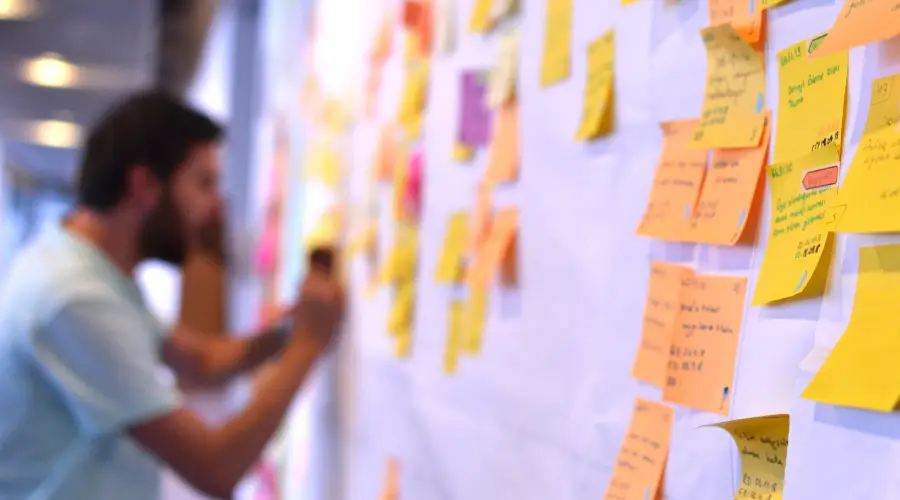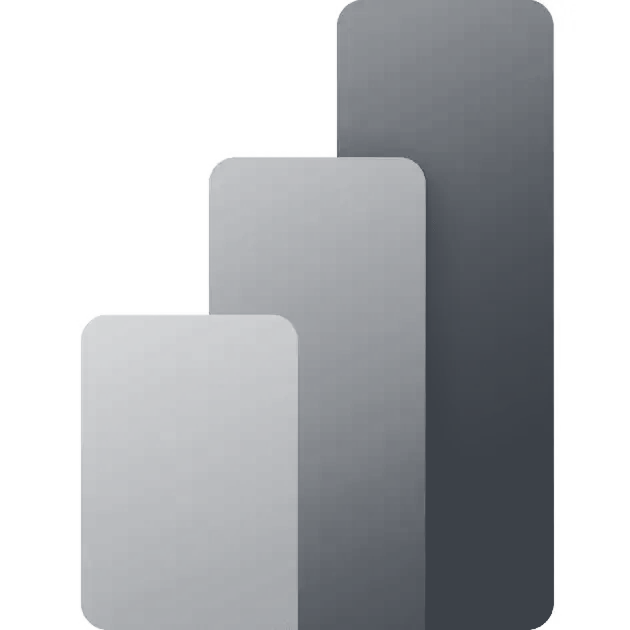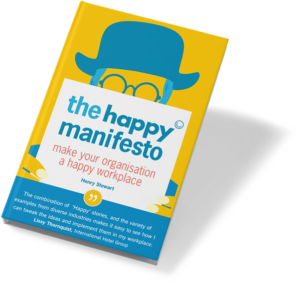I’m Sarah. I’ve been to every happy workplace conference, because it’s amazing. I’m hugely honoured to be up onstage and I’m going to tell you the story of Sure Petcare and about why a happy workplace matters to the customer experience and to customer service.
So our company, Sure Petcare, started in 2008. Our MD is a physicist trained in Oxford and Cambridge, one of the smartest people I know, and he had a problem. His cat was getting stressed in his own house by other animals coming in. Cats hate collars, so the only solution to that at the time was to put a magnet on your collar. Did anyone here have a magnetic cat flap at any point in their life? Did you have lots of ball bearings, forks, larger items [coming towards it]? Yeah, it’s quite a common issue.
So he just a developed a new technology as you do when you have a problem and that’s how Sure Petcare was born. We started with making microchip operated cat flaps, giving your pet their own door key is what we said. We’ve moved into feeders, stopping pets from eating each other’s food or your little humans from eating your cat food.
How many people here actually own a Sure flap or a Sure Petcare product? Oh my god, that’s the most amazing thing. I’ve been talking for a number of years and I sometimes get one person, so thanks. How’s the customer service? Yeah! Awesome.
OK, so we started this business, we knew we had a great product, but nobody knew about the technology and nobody knew that it existed. So it actually didn’t matter that we had a great product if we didn’t back it up with great service. What happened really early on was a fantastic… we outsource our customer service and someone had a problem with their cat flap. So the customer service department asked them to take the cat flap out of the door and send it back to them and they would fix it and send it back. If anyone has a cat flap in their door they’ll know that means you’re left with a giant hole in your door for an indeterminate amount of time. Not the most amazing of customer experiences, as you can imagine.
We very quickly decided, actually, we should do that as much of ourselves as we could and that was going to be one of the major factors in how we built the business. In the last ten years – we just celebrated our ten year anniversary – we’re now selling in 35 countries, we’ve got over a million customers, we support them in over four languages. Our net promoter score has been anywhere between 90 and 97 for over nine years. How many people here work in customer service or customer facing organisations? And how many people know what net promoter score is? OK, so I won’t have to explain it too much.
The turnover in my customer service department is fantastic. I used to be able to say we had no turnover – in seven years we had no turnover. Since then we’ve had three people leave actually, but one of them has come back. And really all the important things that come from great customer service has actually been about creating a great place to work.
I know a lot of you work in the charity industry and I left a charity to go and work for a cat flap company. I found out that I was happier at work and I had more purpose at a cat flap company. I’ve actually spent the last nine years since I left that charity trying to figure out how that’s possible. So that’s what I’m going to share with you. It’s actually about having a great workplace and a happy workplace. In customer experience, it’s the biggest differentiator.
By next year, 90% of customers will be choosing where they do business based on the customer experience. I found this quote, which is hugely important because we used to work with our hands, right now we work with our heads, but the future of business is really we’re going to be working with our hearts. The top leadership statistics about what people wanted coming out of LinkedIn this year have to do with empathy, resilience. So those much softer skills, some people say maternal skills, are now becoming the top leadership qualities.
In customer experience, what we know is that the difference between a crappy customer experience and an amazing – so on that NPS score, a 0 to 6 and a 9 or 10 – if you listen to the free text of that, what happened was a human did something extraordinary. That’s where you have the difference between an OK experience and an amazing one. It’s all about the humans. Great customer service starts with the people who deliver it. That’s what we discovered.
This is at our tenth birthday party. We took a picture and put it all together of every employee over the ten years. Every time it stops, that’s one year in our staff. We realised over the years, what you can see is actually most of those people were there really, really early on over those ten years and we’ve had really low turnover the whole way along. But the difference in customer experience and in a happy workplace is the same; it’s the people.
One of the things that’s the most important for me is creating a connection with your staff. We’ve had a huge amount of change and growth over the years. We were acquired in 2015 and we’ve actually just been acquired again. That has its own challenges coming from a very small start-up where there was four of us in a building to now being part of MSD, which is a multinational pharmaceutical in the tens of thousands of employees.
We do a lot of things to intentionally create connection between our staff, but it’s really, really key to do it with intention, not just to create fun. So this is some of the fun stuff we do: we have Christmas jumper day and Christmas parties, we had a moustache grow for Movember a couple of years ago, we dress up for Halloween and we have a lot of fun together. But I’d like to tell you a little story about what it means to me to create a personal connection.
When I came back from maternity leave in 2017 we had been acquired and I really wasn’t sure that this was still the right place for me. There was a lot of change and a lot of difference and I wasn’t feeling connected to the company in the way I had previously. And I came in and that week two things happened. One of my staff who had been with us for a number of years came into work and let us all know that her mother had been diagnosed with terminal cancer, but she wanted to come to work to be with people who she knew supported her. She knew that she was safe and in a place where she could bring herself to work in those worst case scenarios – on your worst day she could come to work and be with the people that she has a connection with.
Four days later one of our other staff members came in to show us a picture of a scan. He and his wife had been trying to have a baby for ten years and we were the first people that he brought that scan picture to after telling his family. And that week, no matter what the challenges were, showed me that by creating that connection in my team – by creating an environment where people brought their whole selves to work – that that was a place I still wanted to work. We could have our highest highs and our lowest lows together and that was important. All of the rest of the pieces about delivering great service come from having those connections and those relationships.
So my first question to you, I’ll get you just to talk to your neighbour or talk as a group, what’s something you could do, it could be big it could be small, to create a deeper connection, a meaningful connection with the people in your team when you go back to work tomorrow?
Delegate 1: ‘Sounds a bit corny, but just being curious or having a curious intent.’
SM: Awesome. He’s totally stealing my thunder for my next slide, honestly. Anybody else?
Delegate 2: ‘We were just saying about noticing the little things and remembering, not work things, just personal things. You know, how did your wedding go at the weekend? Or little nuggets.’
SM: Yeah, because we know those things don’t we. That’s an awesome way to do it.
Delegate 3: ‘We had space issues so I gave up my desk so I’ll just sit anywhere now, but that’s had a big impact sitting in different teams. You don’t know where you’re going to be sitting sometimes when you go in, but you’re amongst different people so I think maybe being deskless and moving around if possible.’
SM: Yeah, create those connection places, right? That’s great. They’re really simple things to do actually and just continuously building those simple things.
So I’m going to share with you, I do a lot of public speaking, I’ve done eight countries in nine weeks, which is a really bad idea – don’t ever do that. Henry phoned me on Monday and said, ‘I would like you to tell more stories and give a different presentation than you usually give.’ And I went, ‘shit, OK.’ And he said, ‘You know Sarah we’ve known each other for a long time, but I don’t actually know what you do to make your staff happy. So I want to challenge you to tell people that.’ And I went, ‘Awesome idea, thank you Henry.’ He’s so good at making me really uncomfortable and grow as a human being, so I’m very grateful.
Then we hung up and I went, oh my god, I don’t know what I do. I just do it, because for me it comes naturally. It’s something that I’ve never thought about. I’ve spent all that time trying to figure it out because it just feels right, so I work in my why of feeling a lot. So I did what I always do, actually, which is part of the key – I asked my team, ‘what makes you happy at work?’ And they said a lot of things about it being easy to get help, not having their performance assessed, freedom, control, flexibility; all of those pieces I think we’ve heard over and over again today.
But the thing that stood out for me really actually was it was really more about what I don’t do. So in a customer service environment, we’re very keen on metrics. We love what we call SLAs, which are service level agreements, which makes no sense, actually. We like to measure all sorts of things like average handling time and first call resolution and ten out of ten call metrics. And I think that’s a really great way to destroy the customer experience and provide the worst possible customer service you can.
I’ll give you an example of that. A ten out of ten call metric could go just like this: ‘Hello Henry,’ so I’ve ticked that I’ve used his first name. ‘How are you today?’ I have greeted him in a kind and friendly manner. And then after not solving his problem I could end the call by saying, ‘Is there anything else I can do to help you today?’ And that would score a ten out of ten in our customer service world.
So I don’t actually have SLAs or metrics. I really believe in training my team very, very well. So I tell them to give themselves six months before they should feel comfortable and confident with our products. Other things I don’t do – I don’t get mad if they’re late because they’re stuck in traffic. That came up from five different people. I don’t measure people. I don’t ask them how long they’re going to be on the phone for. I train them very, very well and then I let them do their jobs with a very clear guideline that their job is to do what it is that makes the customer happy.
A number of years ago we switched from having a 30 day money back guarantee to a 30 day happiness guarantee, because actually most people who interact with you, your service, your product – and this goes for internal as well – they don’t want their money back. They’re not going to buy your product because they want their money back. They buy your product because they want to be happy with it. So what’s the problem you’re trying to solve with your product? Then they want to be happy with it.
My team have the ability to do whatever it takes to make the customer happy. And that means they can go to their homes, they can phone up fitters and have them come in and do that. It means we don’t make customers take their cat flap out of their door and send it to us so we can fix it. We trust our customers and we just send them a replacement and a free post bag and we get it back when they’re ready and when it’s convenient for them.
I’d like you to think about that now and think a little bit about what’s something you could stop doing. I know Henry did the huge thing and he stopped making decisions, which I’m getting there. So what’s something you could stop doing right now that could help you deliver better customer experience or a better employee experience if you don’t have customer service?
OK, you guys clearly have a lot of stuff you could stop doing. Just think about the savings in time alone in your organisation, right, when you don’t do stuff. Does anyone feel comfortable sharing what they’re going to stop doing?
Delegate 4: ‘The number of emails I send, because being HR we were just saying that we’re very driven by this thing of audit trail and you’ve got to know what happened, when and who. But obviously there are situations where you don’t need to send an email and especially if you work in a large open place office with everybody else. So that’s something I’m going to try and be more mindful of.’
SM: That’s an awesome idea, not sending as many emails. Anybody else have something they can stop doing?
Delegate 5: ‘So I said I want to stop trying to make everybody happy. [Laughter]. I got that laugh at the table. We’re trying to make everybody happy and we’re ending up making nobody happy.’
SM: I disagree just ever so slightly with the delighting our customers. I think delighting our employees is great. Delighting our customers means we might never solve their problems but we’ll send their grandmother a stuffed toy giraffe because we saw it on Twitter, right?
Delegate 5: ‘All of our stuff’s internal. I’m thinking about some of our policy people, maybe, and not necessarily trying to focus on our internal customers and not all the other stake holders we have.’
SM: Anybody else? Something I started doing a long time ago that I still am not great at but I have a Post-It Note on my desk to remind me, which just says ‘What do you think?’ Because as a manager it’s really fast and easy for me to answer someone’s questions and tell them what to do when they ask me, so I have to set myself that reminder to actually say, ‘What do you think?’ And just like Henry did for me, it makes my team very uncomfortable, but it’s good for their personal growth so I’m going to keep doing it.
This is a question that Henry can attest to that every year for the last seven years at the end of the conference I put up my hand and I say, ‘How come we’re not doing it?’ We all know that happy workplaces make more money, they’re more profitable, there’s more creativity, lower turnover, less shrinkage – who doesn’t want that? Every possible metric in a business or a charity or any organisation you want is improved by creating a happy workplace, right?
The reason this belongs in customer service is, if you look at that value-service-profit chain, happy customers spend more, they’re more loyal, they’ll stay with you longer and you’ll make more money, but you can’t do that without happy employees. You will not get great customer service without happy employees. So that’s one of the pieces for me about why we’re not doing it.
Andy de Vale who has been here a few times, he did this for Corporate Rebels. He allows me to use this in my presentations, I think it’s beautiful and I think this is a huge part of the problem. The people who do the work have the answers. Those are the people who speak to your customers, who hear their frustrations, who use your systems, who hear the difficulties that your business has every single day. That’s what you pay them for. And what do we do? We get consultants in and they tell us where our problems are and they charge us lots of money and they tell managers how to fix it and managers tell leaders how to fix it and they tell their team members how to fix it and the staff go [puts head in hands].
There’s a fantastic story, not my story, but I love this story. A gentleman I know phoned up a bank. Him and his girlfriend they live together in the same house. That bank has fantastic AI and it has voice recognition technology so it answered the call and said, ‘hi David.’ And he explained him and his girlfriend have lived together for a long time, they both have accounts. They go, ‘yes we know. We know your partner. We can see she lives at the same account, no problem.’ So they’d like to take one of their individual accounts and convert it to a joint account. Fantastic, they can see them, they know who they are, that’s wonderful.
Then the voice of the customer service agent dropped when she said, ‘I’m going to need you to go to a notary public with your girlfriend and have them sign this six page document stating that you live at the same address and then mail it to us, and it should take six to eight weeks for us to be able to open that account for you. I’m really sorry.’
So we put these barriers in place of our customer service departments and they know, they hate having to tell customers those things, when they know it’s wrong, when they know it doesn’t have to be that way. Sometimes things are regulatory and you have to do that. That particular one wasn’t because after six weeks and I think 10,000 complaints, they scrapped that completely.
There’s a piece in this digital world where we’ve got this fantastic augmentation that we’re going to use, which is automating the transactional, like opening up a new bank account, and leaving space for the human interaction where it’s emotional, where it’s complex and when it matters to your relationship – that’s when you put your people in. But don’t confuse them and don’t use paperwork as an excuse or a process.
So back to my question. Why aren’t we doing this? There’s two things. One: delivering happiness is simple not easy and we’ve heard that a lot. It’s really simple and it’s a lot of small things today are the things you can do to make changes and a lot of them are free. One of the problems is the message isn’t clear. So just like in customer service we measure all the wrong things, in workplaces we give people all the wrong things. We give them ice cream, free smoothies, apples, fruit bowls, compensation, perks, benefits.
To Cathy’s point first thing this morning, I don’t think anyone put up their hand when they had something with joy about being well paid. That’s not what makes us happy at work. We give people nap-pods and slides and ball pits, free coffee and all of those wonderful things.
Right, this is the hard thinking bit, but it’s the bit I love the most. I have spent all this time asking people how come we’re not doing this? We know this is the right thing to do. I was very lucky to go to Denmark last year and train with Woohoo, and if you don’t know them I recommend you look them up. The piece that I took away from that was we’re doing the wrong things because that’s what we’ve been told to do.
Daniel Kahneman states that we’ve got two kinds of happiness. We’ve got what we call evaluated wellbeing, which sits up here, and experience wellbeing, which sits in our hearts. So our heads and our hearts. What happens is all of the things that we think about when we evaluate, actually, I’ve had a bad day at work or I’m not happy at work, but I get paid well and we’ve got free coffee and I enjoy working there, it’s a lovely office space and I get a good bonus, so actually I’m pretty happy.
All that does in real life is actually help you decide to move to Google because Google has all those things. And I know this because my cousin works at Google and she said that that’s what attracted her. She got a huge pay rise and all sorts of fantastically wonderful things and it has bicycles and colours and nap pods and anything you could possibly want. But actually what makes her happy at work is she gets to go to work every day with the smartest people she’s ever worked with and do amazing work with them.
The things that actually make us happy at work are the things that everyone has alluded to today, and that is doing great work together with great people. So do you have results? Do you know that what you do matters? And do you do it together with great people? That is the key to happiness at work. That gives us all of the positive benefits we want. And the reason that we don’t do it is because we haven’t been told the right things, but also because that’s a lot more difficult.
What that means is we have to give of ourselves and the same is true in customer experience, because humans are happy in both places. So what makes our customers’ experience amazing is that we delivered them an outcome, the results they wanted, and we had a relationship with them. So it’s exactly the same. What makes us happy at work is what makes us happy at home.
The impact on happiness at work is way bigger on job satisfaction. So even if the only thing you want to do is attract people to your company then you can still just make people happy at work. And the only thing that you can’t do is take away those ice creams, because it has a massive negative impact on people. So if you have all of those things then I’m afraid you’re stuck with them.
We did that at work. We thought we were spending lots of money on company lunches, which we do every Thursday to increase our connection with our staff and give them a place to connect, and we thought we could spend that money on things like healthcare or free gym memberships or any of those types of things that sit in that bottom box. And we got a resounding 99.9% of people do not want to give up their company lunch.
How many people have worked somewhere where they used to give you free coffee or they used to give you sandwiches and then they took them away and you still talk about it? Yeah, humans don’t like to lose stuff; we’re not very good at that.
That for me was the biggest eye-opener I think I’ve had in my life and it means that we have to spend a lot more time and a lot more personal effort on our staff and how we do that. Until and unless we do that with the help of fantastic human professionals, we will not make people happy at work, they will not stay longer, and they will go elsewhere. Millennials are much more switched onto this than most of people of my generation.
I’m just going to give you a couple of my examples of things that I do that are small that maybe you can add to your growing list of things you have to do tomorrow. So the 20 second rule I believe is one of the easiest ways to get people to do that. My team have a rule, which is if something is making their lives or our customers’ lives 20 seconds more difficult – and you can even make his smaller, you can make it five seconds – if you imagine making something 20 seconds easier and multiply that by the number of your staff and the number of calls you get into your customer service organisation and the number of cases that happens, you’re getting a lot of time back by solving one very tiny solution.
We have a 20 second rule list in our office, which we’re consistently updating. So, any time they come across something that’s making our lives more difficult we encourage them to write it down and then my job, I believe, as a leader and manager, is to fix that.
I think it was Dom at your [previous happy workplaces conference] who suggested letting your new staff tell you what to fix. So I gave them a book which I said, ‘Can you write down the crazy shit we do in that book,’ and they called it something different. I gave this to my new staff, every time they start, to write down those things they can see that we don’t. You just do stuff naturally, don’t you, the longer you’ve been there? And you don’t see that it seems insane to take this and walk it over to this department and then get them to stamp it and then walk it back to your department over here, because you just do it naturally, that’s the way it’s always been done. Maybe, like us, those departments used to be next door so it made sense at the time.
So we allow them to do that and then we change things based on that or explain to them why it’s like that, and then probably change them anyway. What that does is two things. It creates a connection with them – it makes them know straight away that what they say matters in your business and it gives them the ability to later on share when things are really bad and really wrong and they trust that you will make things better. So you’re building up trust and connections straight away.
I love random acts of kindness. If I could do that for my job and get paid for it that’s literally all I would do.
We stole this from Tim Dorsett at Innocent Drinks. They had a lift of love. We don’t have a lift, we just have a lunchroom, so we created the lunchroom of love and we played Barry White all day and we asked people to write Post-It Notes about the other members of staff, things they were grateful for and things they liked for them. We as the committee actually put a whole bunch up, because you never want to be the first person to put up a sticker or raise your hand at a conference, right?
It was great. It had a super impact on that day. People loved it. They were coming and they were laughing, they got cake, it was great, it was fun, but we took it a little step further and we surprised them later. So at the end of the day we took all of the Post-It Notes and we kept them for a month. Then a month later – it was actually about six weeks later – we stuck them into a card and delivered them in the morning to everybody’s desks, so they got to relive what people had said about them. Every single member of our staff – that was in March – still has their card on their desk.
It means so much to hear those small little pieces from your colleagues creating those relationships together about what they like about you. I would recommend that you take five minutes and go and speak to a different member of your staff everyday and you can ask them what you can do for them. Gary Vaynerchuk says the most important thing you can do is to ask your staff ‘what can I do for you?’ So take that away tomorrow and everyday ask a different member of your team ‘what can I do for you?’ and the answers will surprise you.
The last thing is to give people time, because everything I’ve talked about and everything that you’ve heard here today takes time. I guarantee you that if you do any of these things, if you focus on happy staff and especially happy staff in your contact centre, if you remove those stupid rules and get rid of those barriers to allowing them to do their job properly, your customer service will soar. Those are my nickables.
